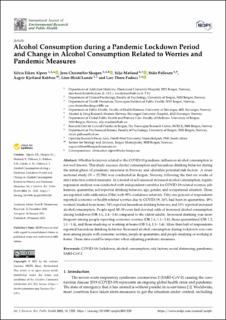Alcohol Consumption during a Pandemic Lockdown Period and Change in Alcohol Consumption Related to Worries and Pandemic Measures
| dc.contributor.author | Alpers, Silvia Eiken | |
| dc.contributor.author | Skogen, Jens Christoffer | |
| dc.contributor.author | Mæland, Silje | |
| dc.contributor.author | Pallesen, Ståle | |
| dc.contributor.author | Rabben, Åsgeir K. | |
| dc.contributor.author | Lunde, Linn-Heidi | |
| dc.contributor.author | Fadnes, Lars T. | |
| dc.date.accessioned | 2021-08-09T11:44:39Z | |
| dc.date.available | 2021-08-09T11:44:39Z | |
| dc.date.created | 2021-02-02T12:59:59Z | |
| dc.date.issued | 2021 | |
| dc.identifier.issn | 1661-7827 | |
| dc.identifier.uri | https://hdl.handle.net/11250/2767019 | |
| dc.description.abstract | Whether lockdown related to the COVID-19 pandemic influences alcohol consumption is not well known. This study assesses alcohol consumption and hazardous drinking behavior during the initial phase of pandemic measures in Norway and identifies potential risk factors. A cross-sectional study (N = 25,708) was conducted in Bergen, Norway, following the first six weeks of strict infection control measures. In a model of self-assessed increased alcohol consumption, logistic regression analysis was conducted with independent variables for COVID-19-related worries, joblessness, quarantine, self-reported drinking behavior, age, gender, and occupational situation. These are reported with odds ratios (ORs) with 95% confidence intervals. Fifty-one percent of respondents reported economic or health-related worries due to COVID-19, 16% had been in quarantine, 49% worked/studied from home, 54% reported hazardous drinking behavior, and 13% reported increased alcohol consumption. People aged 30–39 years had elevated odds of increased alcohol consumption during lockdown (OR 3.1, 2.4−3.8) compared to the oldest adults. Increased drinking was more frequent among people reporting economic worries (OR 1.6, 1.4−1.8), those quarantined (OR 1.2, 1.1−1.4), and those studying or working at home (OR 1.4, 1.3−1.6). More than half of respondents reported hazardous drinking behavior. Increased alcohol consumption during lockdown was common among people with economic worries, people in quarantine, and people studying or working at home. These data could be important when adjusting pandemic measures. | en_US |
| dc.language.iso | eng | en_US |
| dc.publisher | MDPI | en_US |
| dc.rights | Navngivelse 4.0 Internasjonal | * |
| dc.rights.uri | http://creativecommons.org/licenses/by/4.0/deed.no | * |
| dc.title | Alcohol Consumption during a Pandemic Lockdown Period and Change in Alcohol Consumption Related to Worries and Pandemic Measures | en_US |
| dc.type | Journal article | en_US |
| dc.type | Peer reviewed | en_US |
| dc.description.version | publishedVersion | en_US |
| dc.rights.holder | Copyright 2021 The Authors | en_US |
| dc.source.articlenumber | 1220 | en_US |
| cristin.ispublished | true | |
| cristin.fulltext | original | |
| cristin.qualitycode | 1 | |
| dc.identifier.doi | 10.3390/ijerph18031220 | |
| dc.identifier.cristin | 1885866 | |
| dc.source.journal | International Journal of Environmental Research and Public Health (IJERPH) | en_US |
| dc.identifier.citation | International Journal of Environmental Research and Public Health (IJERPH). 2021, 18, 1220 | en_US |
| dc.source.volume | 18 | en_US |
| dc.source.issue | 3 | en_US |
Tilhørende fil(er)
Denne innførselen finnes i følgende samling(er)
-
Department of Clinical Psychology [234]
-
Registrations from Cristin [10402]

